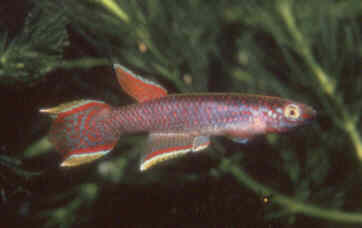| Meaning
of Name |
After Dr.Ernst Ahl a German Ichthyologist based
at the Zoological Museum, Berlin.
|
| First
Description |
Myers, G.S. 1933.
The Genera of Indo-Malayan and African
Cyprinodont fishes related to Panchax
and Nothobranchius.
Copeia, 1933 (4): 183-184.
|
| Size |
6cm
|
| Meristics |
D = 10-12, A = 14-16, D/A = +6, ll = 30-33 (Radda
& Purzl 1987)
|
| Karyotype |
Very variable - 20 (31) : 10 (20)(Scheel 1974)
|
| Sub-Genus |
Mesoaphyosemion
|
| Group |
A.calliurum
|
| Synonyms |
- Haplochilus elegans
non Boulenger 1899;Boulenger 1903
- Aphyosemion calliurum ahli Myers
1933 (nomen novum for Panchax calliurus
var. coerulea Meinken 1932)
- Aphyosemion calliurus ahli
Myers 1933
- Aphyosemion ahli
Scheel 1968
- Aphyosemion pascheni
(non Ahl 1928) Radda 1971
|
Populations
- Basilebeko
- Bipadé
- Bongo
(commercial collection 2022)
- Cellucam
(Bright orange spots to upper body & dorsal fin)
- Edéa
- Efulen (Bates collection)
- Funge
- Kienke (possibly
Kienke River which was imported by the BKA early 1970's)?
- Kribi
- Likado
- Lobé
- Lobé Kribi Bridge
- Lolodorf Road West Kribi
- Londji
- Loum
- Mboumboula River
- Mouanko
- Muyuka
- N'kapa
- Nange
- Sanganali
- Song Makak
- South Sanaga
- Sud Sahara
- Victoria
- ABC 05 / 16 - Solé
- ABC 05 / 17 - Yabassi
- ABC 05 / 18 - 13km after Yingui-Edéa
intersection
- ABC 05 / 20 - Ndorbe River
- ABC 05 / 22 - West NagadjoI
- ABC 05 / 23 - West Naha
- ABC 05 / 25 - Afanouan
- ABC 05 / 26 - Adjap I
- ABC 05 / 32 - Bissiang
- ABC 05 / 33 - Bissiang
- ABC 05 / 35 - Bidou I
- ABC 05 / 40 - Ebunja II
- ABC 05 / 41 - Nlende Dike
- ABC 05 / 42 - Mbode
- ABC 05 / 43 - North Mboro
- ABC 05 / 44 - Before Mboro
- ABC 05 / 45
- ABC 05 / 46 - Near Ebodje
- ABC 05 / 47 - Malaba
- ABC 05 / 48 - Afan Essokié
II
- ABC 05 / 50 - Pondo Road
- ABC 05 / 51 - Bibabimvoto
- ABC 05 / 52 - Afan Essokié
- ABC 05 / 53 - Est Afan Essokié
- ABC 05 / 58 - 700m North Loloabe
River - 10km Mboro
- ABC 05 / 59 - Bipaga I
- ABC 05 / 61 - Bivouba
- ABC 05 / 66 - Est Batombe
- ABC 06 / 77 - Bissiang
- ABC 06 / 79 - Bidou 1
- ABC 06 / 80 - Nkolbonda
- ABC 06 / 96 - Cellucam Road
- ABC 06 / 97 - Cellucam
- ABC 06 / 98 - Kopongo
- ABC 06 / 99
- ABC 06 / 100
- ABC 06 / 102 - Bonepoupa
- ABC 06 / 104
- ABC 06 / 106 - After Ekomtolo
- ABC 06 / 107 - After Ekondjong
- ABK 07 / 132 - Cellucam
- ABK 07 / 133 - Cellucam
- ABK 07 / 136
- ABK 07 / 137
- ABK 07 / 138
- ABK 07 / 150 - West Banga Bukundu
- ABK 07 / 156
- ABK 07 / 157 - Malimba
- ABK 07 / 164 - West Bipaga II
- ABK 07 / 167 - Bidou 1
- ABK 07 / 176
- ABK 07 / 177 - Nkoadjap
- ABK 07 / 184 - Ebomé
- ABK 07 / 185 - Mbeka'a
- ABK 07 / 187 - Nkolbonda
- ABL 08 / 197 - Bipaga II
- ABL 08 / 199 - Bipindi-Akom II
Road
- ABL 08 / 202
- ABL 08 / 203
- ABL 08 / 204 - Ebonja
- ABL 08 / 205
- ABL 08 / 206
- ABL 08 / 207 - Beyo River
- ABL 08 / 208 - South Ebodjé
- ABL 08 / 209
- ABL 08 / 210
- ABL 08 / 211
- ABL 08 / 214
- ABL 08 / 215
- ABL 08 / 218 - Bibabimvoto
- ABL 08 / 219
- ABL 08 / 228 - WWF Ipono-Campo
Road
- ABL 08 / 230 - Itonde Fang
- ABL 08 / 231
- ABL 08 / 232 - Bonjo
- ABL 08 / 238 - Kribi-Edéa
- ABL 08 / 240 - Fifinda II
- ABL 08 / 246 - Cellucam
- ABL 08 / 247 - Cellucam
- ABL 08 / 249
- ABL 08 / 258 - Kompina
- ABL 08 / 259
- ADGP 11 / 01 - Ndonga
- ADGP 11 / 05 - PK24 Kribi
- ADGP 11 / 06
- ADGP 11 / 07 - Likado 8-9 km
Ebodje
- ADGP 11 / 08 - Camp pygmée
- ADGP 11 / 16 - Bidou
- ADGP 11 / 17 - Bidou-Sanctuaire
- ADGP 11 / 20 - Lockbadjeck
- ADGP 11 / 21 - Putloloma
- ADGP 11 / 22 - Putloloma
- ADGP 11 / 23 - Kompina CDC Camp
II
- ADGP 11 / 35 - Mouanko
- ADK 09 / 293 - Bidou I-Bissiang
- ADK 09 / 299 - Cellucam
- ADK 10 / 321 - Bidou
- ADK 10 / 329 - Palmeraie d'Eboué
- ADK 11 / 452 - Afan Essokié
II
- ADK 11 / 453 - 100m North Boutchilika
River
- ADK 11 / 463 - Point Cellucam
- ADL 13 / 45 - Ndockbao
- ADL 13 / 48
- ADL 13 / 55 - Poutloloma
- AP 13 / 531
- AP 16 / 557
- ARK 07 / 132
- BLLMC 05 / 26 - Makoure
- BLLMC 05 / 28- Bissiang
- BLLMC 05 / 29 - Nkolbonda
- C 89 / 23 - Cellucam, 10 km north
east Edéa
- C 89 / 266km - Mouanko-Edéa
- C 89 / 32
- C 93 / 06 - Bissiang
- C 97 / 06 - Bissiang
- C 98 / 06 - Bissiang
- CB 99-06 - Ebomé
- CBL 01 / 1
- CBL 01 / 11 - Bénengué
- CBL 01 / 17 - Fifinda I
- CBL 01 / 18 - Makouré
I
- CBL 01 / 19 - Bidou
- CLL 03 / 16 - Mbebe
- CLL 03 / 17 - Pama-Fifinda
- CCMP 85 / 01 - Muyuka
- CCMPT 84 / 2
Lobe
- CGI 08 / 1
- CI 04
- CMG 13 / 4
- CMG 23 / 4
- CMM 1
- CMM 36
- CSK 95 / 23 - Likado
- EMS 90 / 16 - Benkok
- GEMGSL 19 / 35 - Temelon
- GEMHS 00-04
- GEMHS 00 / 28 - Tica,
E.Guinea.
- GEMHS 00 / 29
- Buabe, E.Guinea
- GEMHS 00 / 35 - Nomenam,
E.Guinea
- GEMHS 00 / 36
- Nguba, E.Guinea
- GEML 00 / 12 - Bicomo
- GEML 00 / 15
- near Bicomo, power plant, E. Guinea
- GEMLB 02 / 26
- GEMLB 02 / 29
- GEMLB 02 / 31 - Pool Movoho
- GEMLB 02 / 32
- GEMLBJ 03 / 39 -
Ntobo, E.Guinea
- GEMLBJ 03 / 44 - Bicomo-Movoho
- GEMLBJ 03 / 47 - Machinda,
24 km E Bata, E.Guinea
- GEMLC 07 / 49
- GEMLC 07 / 51
- GEMLC 07 / 54
- GEMLCG 07 / 64
Carretera Senge-Bata, Km27
- GEMLH 16 / 29 - Nguba
- HJR-14
- HJRK 92 / 15 - 56 km Kribi
to Campo
- HJRK 92 / 18
- Séla river, Somakek to Benkok
- HLM 99 / 20 - Cellucam
- HLM 99 / 23 - Nkolbonda
- HLM 99 / 28
- Afan Essokyé
- JVC 05
- Lobé
- JVC 08 - Lobe
- JVC 17 / 29 - Akok
- JVC 17 / 31 - North Shore Lobe
- KEK 98 / 03 - Kribi Area
- KEK 98 / 06 - Akom II-Bipindi
- KEK 98 / 12
- KEK 98 / 17
- SKC 95 / 23
(Likado)
- A.cf. ahli
- Apouh (Also called the 'blue ahli')
- Dibeng
- Muyuka (west Mungo)
- Edea - Yaounde Km 10 (Also called
the 'blue ahli')
Ref: KCF Website
|
|
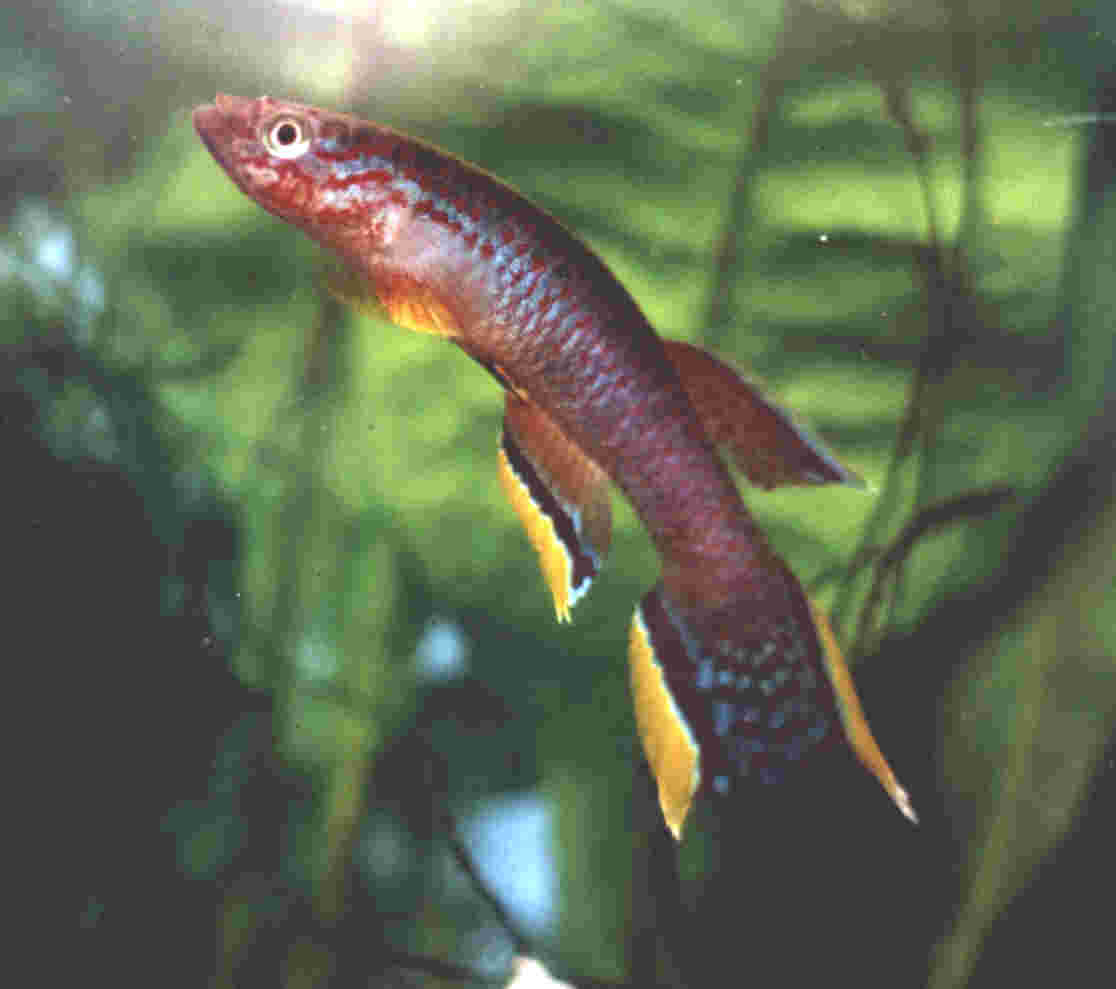
Wild male imported
to the UK 2001, collected at Kribi.
Photo courtesy of Roger Gladwell.
|
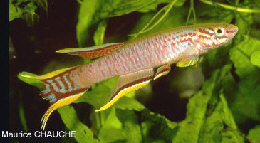
CCMPT 84 / 2 Lobé
Photo courtesy of Maurice Chauche & the
KCF website.
|
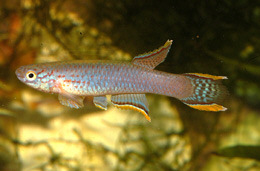
Kribi.
Wild male imported into the USA early 2003.
Photo courtesy of Tony Terceira.
|
|
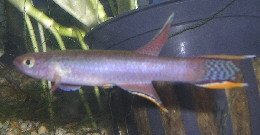
CI 04. Imported into
the USA 2004.
Photo courtesy of Joel Saunders.
|
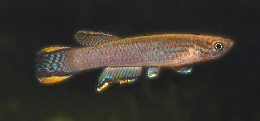
Wild male found
in commercial import to the USA in 2004. I understand enough
fish were found to establish a brood stock. Distributed
as CI 04.
Photo courtesy of Tony Terceira.
|
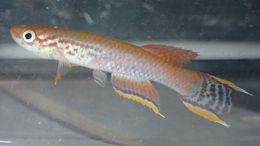
CMG 23 / 4
Photo courtesy of Vasco Gomes
|
Kienke River - This population was well
established in the BKA in the early part of 1973. Not sure if this is
what is referred to as the 'Kienke' population.
|

Muyuka
|
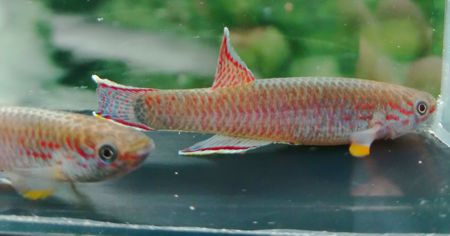
Muyuka
|
Muyuka - Males from commercial import
to UK December 2022. A few came in a bag of Procatopus
similis collected at Muyuka. Although with commercial imports
it's not a verifiable certainty they were collected here I think their's
a very good chance they did. Also in the bag A.volcanum
& E.grahami.
It's interesting that the outer margins on the dorsal & anal fins
are blue.
Also, Amiet in 'Faune du Cameroon' shows a colour plate ( 61 ) of an
A.ahli from Muyuka with the same bright yellow in the pectoral fins.
This fish also had a yellow marginal band in the anal fin.
- CCMPT 84 / 2 http://www.kcfweb.com/image/photo/chauche/image0.htm
KCF Library
- SKC 95 / 23 http://www.aik.it/fotografie/ahli.jpg
AIK Library
- CGI 08 / 1 Collected close to the type
locality of A.campomaaense on
the Kribi to Lobé falls.
- CMM 36
- Found sympatric with A.melinoeides.
- Scheel 1966 - 35 km north of Douala, Mboumboula
river.
- Clausen 1966 - 7 km north east of Longji on
the road to Edéa.
- Roman 1966 - 19 km from Bata towards Machinda,
Equatorial Guinea.
- Roman 1968 - Between Ebam and Macora, Equatorial
Guinea & Senye to Izaguirre, Equatorial Guinea.
- Castelo 1985 - 7 km Bata to Mbini, E.Guinea.
Bato - Movo, trib. Ecucu, E.Guinea.
Alrededores from Machinda, E.Guinea.
- Castelo 1987 - Bome, Rio Mocuasi, E.Guinea.
Ata-Bicomo, trib. Ecucu, E.Guinea
- Castelo 1989 - 5kms south of Kribi
|
| Type
Locality |
Described from live specimens imported into Germany
as part of a commercial import. The exact location of the specimens
used to describe the sp. is unknown. Thought to be Nziou, immediately
south of Longji (DKG).
|
| Distribution |
Range extends from the Wouri River, western Cameroon
south to the Rio Benito drainage of western Equatorial Guinee (formerly
Rio Muni).
Distribution map.
|
| Habitat |
Found in shallow, stagnant pools & swamps
in forested areas but has also been collected in shaded flowing streams.
This sp. is restricted to the coastal plain.
Scheel measured the water in the biotopes as being 0-4 DH, pH 5·6-6·8.
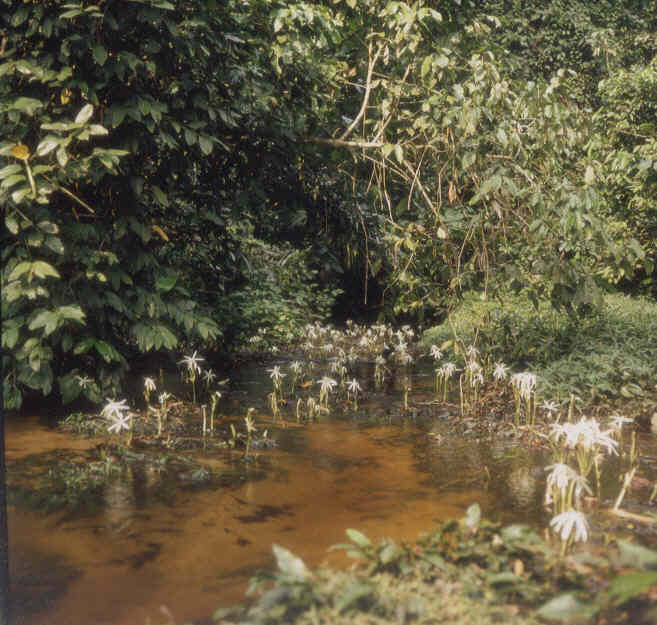
Biotope close to Kribi where A.ahli,
E.sexfasciatus & Procatopus
nototaenia were found.
Photo: Courtesy of Ed Pürzl.
|
| Distinguishing
Characteristics |
A.ahli is
often confused with its close relative A.calliurum.
Generally, A.ahli has less colouration
on the body. They are quite a variable sp. in terms of colouration between
populations. The Kribi population shows vertical red crossbands on the
posterior part of the body to a greater degree than populations found
more northerly.
A more recent sp. which is very similar to A.ahli
is A.pascheni which, although described
in 1928 has only been available to aquarists in the 1990's. I have not
kept them yet but the fish I have seen appear darker with fainter outer
margins to the dorsal & upper caudal fins. Anal & pectoral fins
appear identical. A.pascheni festivum
is a more striking fish all together.
|
| Colour/Pattern
Variability |
Moderately
high. |
| History |
This sp. was first imported into Germany in 1910.
A later import, again to Germany, arrived in 1913. Both shipments were
said to have been collected in the Cap Lopez area of Gabon. The 1913
shipment differed to the previous shipment in that males did not develop
vertical red bars or spots on the body. This 1913 shipment was distributed
under the name of A.calliurum. G.A.Boulenger then of the British
Museum (Natural History) meanwhile identified preserved material from
this later shipment as A.cameronense.
In 1932 a third shipment of this strain arrived
in Germany & were described as Panchax
(Aphyosemion) calliurus
var.coerulea by Meinken, but Myers
found the name coerulea to be pre-occupied
& re-named them Aphyosemion calliurum ahli
Myers 1933. Again, the exact collecting site for this strain remains
unknown.
The Kribi population was collected by A.C.Radda
in 1972 in a well shaded stream flowing from primeval forest. The stream
was located 20 km from Kribi along the Kribi - Bipindi road. This stream
in fact crossed the road at the collecting point which was .6 - 2 metres
wide & 5 - 20cm deep. Water temperature was 23.5'C, pH 5.7, DH 1.
Sympatric sp. included A.bivittatum,
A.pascheni, Ep.sexfasciatus
& Procatopus nototaenia.
The Edea population was discovered by Roger Langton
in 1971 in a small pool 11 km east of Edea on the road to Yaounde. Sympatric
sp. included Ep.sexfasciatus &
an orange form of A.bivittatum.
This biotope was shallow & covered with twigs, branches & a
good deal of decayed vegetation.
The BKA imported 2 different populations in the
late summer of 1972. One of these populations was collected in the Kienke
River, Cameroon. These were later distributed to BKA breeders team members
in October 1973.
|
| Breeding
Notes |
A.ahli is a typical top spawner, laying eggs
in floating plants or spawning mops. I have found this sp. to be quite
shy & slow to start spawning in new surroundings. This can be remedied
by putting a piece of brown paper over the front of the spawning tank.
The water incubation time for this sp. is 2 -
3 weeks. Fry are very small on hatching & do best on infusoria for
the first few days.
Eggs may be placed on damp peat where incubation
can be streched to 30 days.
Although books say they eat newly hatched brine
shrimp on hatching I prefer to use Infusoria for a few days. San Francisco
Bay brine shrimp (which is smaller than Utah shrimp on hatching) can
also be used.
A breeding report on the Kienke River collection
imported by the BKA in 1972 is found in BKA newsletter No.92, April
1973. The spawning medium was peat fibre. Eggs were laid in the bottom
third of the tank. Water incubated eggs took 14-18 days to hatch. Newly
hatched fry were small but quite robust. Infertile eggs were about 5-10%
of those laid.
Eggs were missed in collecting & these hatched in the parents tank.
They grew on unmolested by the parents. Young presented no problems
in rearing & started to sex out at about 1". Young left in
the parents tank were noted as growing faster than those grown on in
a seperate tank.
George Scarth maintained his newly hatched fry in green water &
fed them 'Liquifry' for the first 2 days before graduating on to newly
hatched brine shrimp.
In BKA newsletter No.130, June 1976 a breeding
account by Roger Langton on the Edéa population stated he used
well aged water. He found the pair to be prolific. Eggs water incubate
for 14-21 days & fry are able to take newly hatched brine shrimp
as a first food.
|
| Diameter
of Egg |
1.1mm |
| Remarks |
Although a fairly shy sp. A.ahli
is easily maintained & spawned. As with most Aphyosemion
sp. they are expert jumpers so a close fitting lid is essential.
The Kribi population was regularly seen in UK
auctions in the 1990's. Wild fish from commercial collections do appear
from time to time.
|
